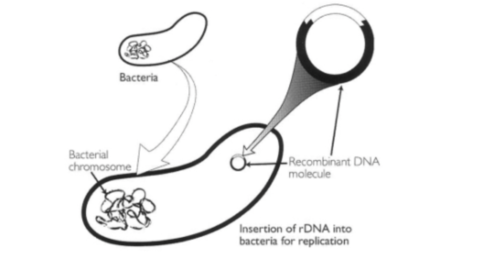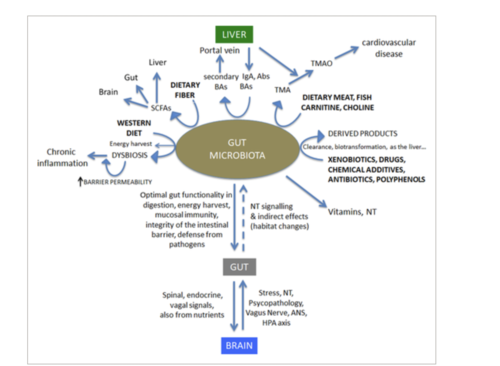Genetically Modified Foods and Their Impact on Human Health
Introduction
Genetically modified foods can be described as foods whose genetic material has been altered in a particular way that is not naturally occurring. In genetic modification, the intended gene is inserted into the genome of a crop manually. A genome is the entire set of DNA instructions found in a cell. Determining whether genetically modifying foods as a safe or ethical process is extremely controversial. We will look at an experiment within this article that studies control rats as well as rats with a 90 day supplement of affected food. and the effects of T2A-1 rice on the GI health of rats after a 90-day supplement.[1] Some researchers also believe that genetically modified foods (GMF) can lead to gut health issues and other diseases. Due to GMFs being extremely controversial, this leads to many social disparities among environmentalists and social activists. This article will also look at the genetics that are involved while modifying foods.
Genetics

Figure 1. Recombinant DNA being inserted into bacteria so that foreign DNA will replicate naturally.[1].
The history of genetic modification dates back to 1944, when scientists discovered DNA modification technology. Scientists discovered that genetic material can be transferred between different species.[2] In 1973, Stanley Cohen developed DNA recombination technology, showing that genetically engineered DNA molecules are able to be transferred among different species. Stanley Cohen was a biochemist from Brooklyn, New York. Cohen shared his Noble Prize in medicine for the discovery of chemicals that promote and help regulate the growth of cells. The process of creating genetically modified plants started in 1983, with antibiotic resistant tobacco and petunias. Later in 1994, the US market created the first genetically modified tomato that was approved by the Food and Drug Administration (FDA). Today there are many crops that have received FDA approval and are consumed by many populations across the globe.
One common gene that is inserted into crops is the Bacillus thuringiensis insecticidal toxin (Bt) gene.[3] The Bacillus thuringiensis insecticidal toxin gene includes a range of different cry1Ac genes, and expresses gram-positive spore-Bt toxins that have been used in insect-resistant biotechnology for many years.This gene has a long history of safe use.The cry1Ac gene encodes a protein that is poisonous to certain types of insects. Scientists will cut the Bacillus thuringiensis gene from the bacterium DNA and insert the gene into a vector that has a selectable antibiotic resistance marker gene(Figure 1).[4] Scientists then load the vector-coated particles onto a teflon bullet which is then loaded into a gene gun. A gene gun shoots the particles at a very high velocity which penetrates the plant. Only the cells that have incorporated the vector will grow and the result will be insect resistant plants.
Microbiome

Figure 2. The complex interaction between the human gut microbiome and other organs of the host.[2].
To understand the effects that genetically modified foods can have on the human body, we must first understand the gut microbiome. The human gut microbiome is a complex part of the human body. Around 60 tons of food pass through the GI tract or gut microbiota, as well as an abundance of microorganisms that create a huge threat to the gut.[5] The gut is one of the largest interfaces between the host, environmental factors and antigens within the human body. The microbiota benefits the host by strengthening gut integrity and shaping the intestinal epithelium, harvesting energy, protecting against pathogens, and regulating host immunity. These mechanisms can be disrupted due to altered microbial composition, dysbiosis. Dysbiosis can be defined as an imbalance in the gut microbial community that is associated with disease.
Moreover, many researchers believe that there is a connection between genetically modified foods and the gut microbiome. The use of glyphosate in genetically modified food environments may cause imbalances of gut bacteria and cause gastrointestinal health issues in humans like cardiovascular disease, depletion of nutrients, birth defects, and many more. Glyphosate is a synthetic compound which is a nonselective systemic herbicide, particularly effective against perennial weeds.[6]
Social Disparities
While biotechnology has tremendously helped the world prosper, it has also created social and ethical contradictions. The debate between whether or not biotechnology can be used for creating high quality crops while still protecting the ecosystem and human’s health is discussed by many environmentalists and social activists.[6] There is concern regarding the health of the overall population, as some health risks pertinent to unapproved GMFs include antibiotic resistance, aller-genicity, nutritional changes, and the formation of many toxins. Many social activists claim that biotechnology companies insist on producing genetically modified crops because they can be privatized, while ordinary crops are a part of the natural property of all humanity. Many environmentalists claim that there is a possibility for long term consequences. Environmentalists are concerned that genetically modified crops could create superweeds and superpests. The superweeds and superpests could potentially disturb the balance of nature as well as pose negative implications on affected insects.
Experiments

Figure 3. Graphs A and C show the weight growth for males. Graphs B and D show the weight growth for females over a 14 week period.[3].
We are able to look past experiments to better understand if genetically modified foods have an effect on humans. Due to the ethical problem that testing on humans can lead to, most experiments have been performed on rats to better understand any effects. A 90-day-rat-feeding study experimented using GMO-treated rats as well as control rats that will be fed an equivalent diet. The GMO-treated rats were fed with MON863 which is a genetically engineered variety of maize that contains nptII. NptII is a marker gene for antibiotic resistance. In the male rats that consumed MON863, there was a weight decrease of 3.3% while in females there was a 3.7% weight increase(Figure 3).[1] Chemical measurements revealed signs of hepatorenal toxicity. Hepatorenal toxicity is the toxicity of the liver and kidney, causing major damage to both organ systems. This occurs when the kidneys stop functioning properly in people who suffer from liver problems. The data also showed 24-40% increase in triglycerides while urine phosphorus and sodium excretions diminished in males by 31-35%.Triglycerides are a type of fat that circulates in the blood, and when the liver becomes dysfunctional, this can cause an increase in triglyceride levels in the affected person. Though the studies results are factual, a limitation to this study is that the trial only lasted 90 days. If the experiment lasts longer than 90 days, then the results would be more helpful for human knowledge as humans live way far beyond 90 days.
Why or why not modify Food?
There are many advantages and disadvantages to genetically modifying foods. Some advantages would be added nutrients, fewer pesticides, and cheaper prices.[7] When one is able to engineer a crop, one can create a product that has all of the desired aspects: being fast-growing, healthier, and more resistant to weather or pests. Science has helped to put food on many tables because of genetic modification. Another advantage to genetically modified foods is that prices are lowered. By changing the gene sequences in a crop, scientists are able to speed up production rate using less land, water, and pesticides. The saved time and resources is able to lower the prices for consumers. Genetically modified foods are proven to also improve some factors of human health. Scientists are able to modify some crops so there are more vitamins and minerals. Providing more positive health benefits helps the human health system tremendously by giving the body the nutrients that it is not always given as well as having more substance making one full faster.
Comparatively, some modified foods can cause allergic reactions as well as increase antibiotic resistance. There can be fatal risks when genetically modifying foods due to the transferring of DNA from other organisms. The unexpected DNA could trigger some allergic reactions that would not normally occur if the food was organic. When inserting new DNA into plant cells, scientists will often also add additional genes that make the cells resistant to antibiotics. By then using an antibiotic, scientists can kill off the plant cells that did not successfully take in the new DNA. The problem with inserting genes resistant to antibiotics is they do not always go away when food is digested. Occasionally, the genes can be passed through feces into the sewage systems. Many experts believe that these genes could be absorbed into harmful bacteria which could be detrimental to overall health. Staph infections can also be caused from the gene being found in the gut which can lead to usual antibiotic treatments becoming powerless against new super-bacteria.
Conclusion
While there have been many experiments performed to better understand genetically modified foods, there is still uncertainty whether or not there is an effect on humans. We have looked at tests done on rats, showing some evidence regarding an effect on the body. In the big scheme of life, the experiment still leaves us with uncertainty, as rats do not have the exact same structure as humans as well as the fact the study only lasted for 90 days. Though some have suggested a correlation between GMOs and human disease, scientists at the FDA have still approved the crops that are consumed. There will always be debates regarding the ethics and safety of genetically modifying any living organism, so it is important that science continues to expand knowledge through strong experimental design, and creative research questions.
References
- ↑ 1.0 1.1 Séralini GE, Cellier D, de Vendomois JS. New analysis of a rat feeding study with a genetically modified maize reveals signs of hepatorenal toxicity. Archives of environmental contamination and toxicology. 2007 May;52(4):596-602.
- ↑ Zhang C, Wohlhueter R, Zhang H. Genetically modified foods: A critical review of their promise and problems. Food Science and Human Wellness. 2016 Sep 1;5(3):116-23.
- ↑ Yuan Y, Xu W, He X, Liu H, Cao S, Qi X, Huang K, Luo Y. Effects of genetically modified T2A-1 rice on the GI health of rats after 90-day supplement. Scientific reports. 2013 Jun 11;3(1):1-9.
- ↑ Pusztai A, Bardocz S, Ewen SW. 16 Genetically Modified Foods: Potential Human Health Effects. Food Safety. 2003;347.
- ↑ Thursby E, Juge N. Introduction to the human gut microbiota. Biochemical journal. 2017 Jun 1;474(11):1823-36.
- ↑ 6.0 6.1 Maghari BM, Ardekani AM. Genetically modified foods and social concerns. Avicenna journal of medical biotechnology. 2011 Jul;3(3):109.
- ↑ Kennedy M, Cassetty S. Pros and cons of gmos: An evidence-based comparison of genetically modified foods [Internet. Insider. Insider; 2022 [cited 2022Dec7].]
Edited by Matthew Nguyen, student of Joan Slonczewski for BIOL 116 Information in Living Systems, 2022, Kenyon College.
